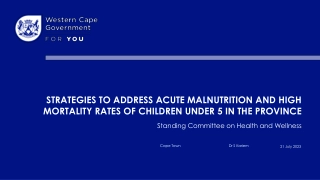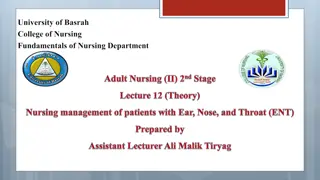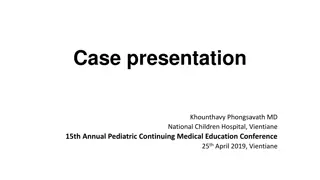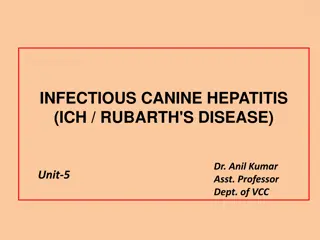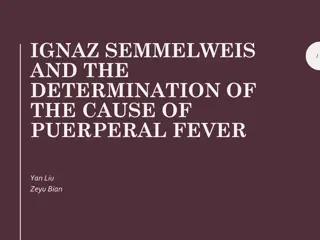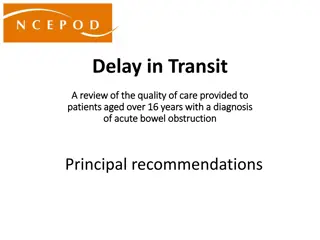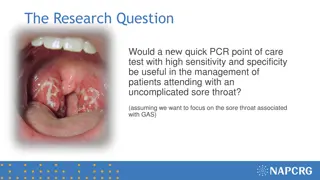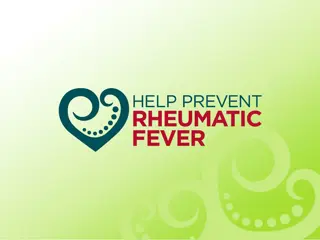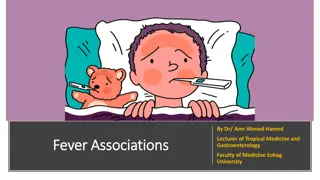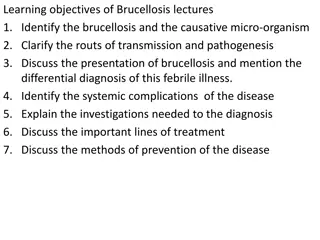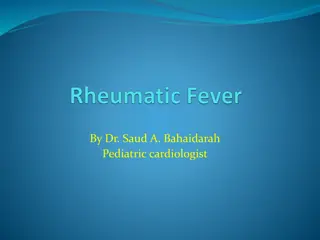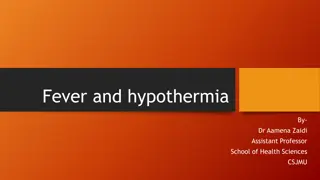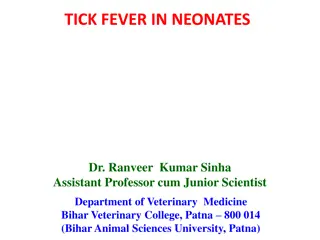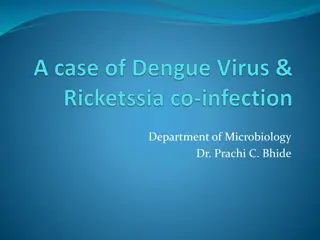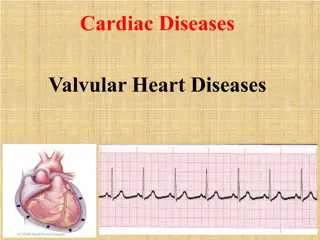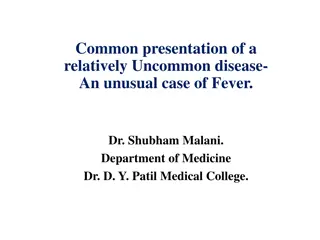Strategies to Address Acute Malnutrition and High Mortality Rates in Children Under 5
Malnutrition in children under 5, specifically acute malnutrition, is a pressing issue in the Western Cape. This presentation outlines the current strategies, multisector engagement, causes, and impacts of acute malnutrition. It delves into the classifications of malnutrition, including severe and m
1 views • 38 slides
Understanding Rhinosinusitis: Symptoms, Causes, and Classification
Rhinosinusitis, formerly known as sinusitis, is an inflammation affecting the paranasal sinuses, nasal mucosa, and nasal cavity. This condition is categorized based on the duration of symptoms as acute, subacute, or chronic. Various factors contribute to the development of rhinosinusitis, including
3 views • 46 slides
Acute orofacial pain
Acute orofacial pain is often associated with dental issues, ranging from dentinal pain to periodontal pain. The pain can be moderate to severe, with various triggers such as mechanical stimulation and changes in osmotic pressure. This pain is prevalent in adults and can spread to different areas of
1 views • 49 slides
Understanding Acute Rheumatic Fever: Causes, Symptoms, and Impact
Acute Rheumatic Fever (ARF) is a multisystem disease resulting from an autoimmune response to a sore throat caused by Group A beta-hemolytic Streptococci. It primarily affects children aged 5-14 years and can lead to rheumatic heart disease (RHD), which is the most common cause of heart disease in c
2 views • 48 slides
Overview of Acute Gingival Diseases
Acute gingival diseases encompass various conditions such as Necrotizing Ulcerative Gingivitis, Necrotizing Ulcerative Periodontitis, Necrotizing Ulcerative Stomatitis, and others. Necrotizing Ulcerative Gingivitis (NUG) is a microbial disease primarily affecting the gingiva, characterized by necros
5 views • 67 slides
Case Review: Diagnostic Dilemma in Urology - Management Approach for a Patient with Abdominal Pain and Fever
A 58-year-old man with a history of diabetes and hypertension presents with fever and abdominal pain, raising multiple differential diagnoses including symptomatic AAA, pyelonephritis, acute appendicitis, complicated urolithiasis, or diabetic ketoacidosis. The case explores clinical manifestations,
1 views • 35 slides
Understanding Enteric Fever (Typhoid Fever): Causes, Contagiousness, and Prognosis
Enteric fever, commonly known as typhoid fever, is an acute illness caused by Salmonella typhi bacteria transmitted through contaminated food or water. This fever is highly contagious, with individuals becoming carriers even after recovering. Close contact, contaminated water, and poor sanitation co
0 views • 18 slides
Understanding Ephemeral Fever/Three-Day Sickness in Cattle and Water Buffalo
Ephemeral fever (Three-Day Sickness) is an acute arthropod-borne viral disease affecting cattle and water buffalo. It is caused by the Bovine Ephemeral Fever Virus and manifests with biphasic fever, decreased milk yield, and other clinical signs. The disease has varying prevalence and can lead to hi
0 views • 7 slides
Global Nutrition Prevalence Rates in Children and Women
This content highlights the prevalence rates of acute malnutrition, severe acute malnutrition (SAM), moderate acute malnutrition (MAM), childhood stunting, acute malnutrition based on MUAC and edema, and acute malnutrition in pregnant and lactating women. The data is based on various criteria such a
9 views • 37 slides
Understanding Inflammation and Its Characteristics
Inflammation is the response of tissues to harmful agents, categorized as acute or chronic. Acute inflammation is rapid and short-lived, while chronic inflammation is insidious and prolonged. Chemical mediators play a crucial role in both forms, leading to tissue necrosis. The five cardinal signs of
3 views • 27 slides
Comprehensive Overview of Acute Abdomen Assessment and Management
This detailed guide covers the definition, general approach, history taking, physical examination, investigations, diagnosis, and management of acute abdomen cases. Learn about common causes, such as acute appendicitis, bowel obstruction, and medical conditions. Real-life scenarios illustrate differ
2 views • 15 slides
Pediatric Case Presentation: Fever and Rash in a 3-Year-Old Patient
A 3-year-old female presented with fever, rash, cough, vomiting, diarrhea, and dyspnea. History revealed incomplete immunization and household fever cases. Physical exam showed tachycardia, respiratory distress, rash, and other symptoms. Past medical history indicated normal development and perinata
0 views • 26 slides
Addressing Rheumatic Heart Disease Disparities in Indigenous Australians
Rheumatic heart disease (RHD) continues to disproportionately affect Indigenous Australians, particularly those living in remote areas, with a high incidence compared to the non-Indigenous population. Acute Rheumatic Fever (ARF) is a key precursor to RHD, often linked to social determinants and poor
0 views • 7 slides
Canine Infectious Hepatitis (ICH) - Overview, Symptoms, and Treatment
Canine Infectious Hepatitis (ICH), also known as Rubarth's Disease, is caused by Canine Adenovirus-1 (CAdV-1), affecting dogs of all ages. The virus primarily targets hepatocytes, leading to acute hepatitis, as well as respiratory and ocular issues. Transmission occurs through contact with infected
6 views • 7 slides
Understanding Bovine Ephemeral Fever: Key Information and Insights
Bovine Ephemeral Fever, also known as Three-Day Sickness or Three-Day Fever, is an economically important arboviral disease affecting cattle and water buffalo in tropical and semitropical regions. It is caused by an arthropod-borne rhabdovirus and primarily transmitted by mosquitoes and biting midge
0 views • 19 slides
Inpatient Management of Severe Acute Malnutrition Training Course 2011
This training course focuses on inpatient management of severe acute malnutrition, teaching procedures outlined in the national Community-Based Management of Severe Acute Malnutrition Guidelines. The training aims to reduce case fatality rates significantly and is designed for physicians, senior nur
0 views • 9 slides
Acute Malnutrition - Fluid Management and Treatment Overview
Acute malnutrition, particularly severe acute malnutrition (SAM), requires careful fluid management and a structured treatment approach involving stabilization, transition, and rehabilitation phases. This condition results from inadequate dietary intake or acute infections, leading to severe wasting
0 views • 23 slides
Comprehensive Treatment Guidelines for Acute Ischemic Stroke
In the management of acute ischemic stroke, the primary goals are to reduce secondary brain damage, maintain adequate perfusion, and prevent recurrent strokes by managing risk factors. Treatment includes maintaining tissue oxygenation, correcting volume status and electrolytes, managing blood glucos
0 views • 20 slides
Ignaz Semmelweis and the Fight Against Puerperal Fever
Ignaz Semmelweis, a pioneer in antiseptic procedures, determined the cause of puerperal fever in the 19th century. His work led to a significant reduction in maternal mortality by identifying the importance of handwashing in healthcare settings. Puerperal fever, a common cause of death in women afte
0 views • 29 slides
Understanding Abnormal Liver Function Tests: Acute vs. Chronic Approach
Comprehensive discussion on assessing patients with abnormal liver test results, focusing on distinguishing between acute and chronic liver conditions. Covers diagnostic workup, patient cases, and differential diagnosis, emphasizing the importance of patient history, physical examination, and key di
0 views • 16 slides
Review of Care for Patients with Acute Bowel Obstruction: Recommendations and Key Findings
This review assesses the quality of care provided to patients aged over 16 years with acute bowel obstruction. Significant delays were identified in the care pathway, from imaging requests to availability of operating theatres. Recommendations include prompt CT scans with intravenous contrast for de
0 views • 32 slides
Comprehensive Guide to Creating and Understanding Acute Care Plans
This comprehensive guide provides detailed information on creating and understanding acute care plans, including the purpose of an acute plan, who needs one, what information can be written in an acute plan, examples of baseline clinical parameters, alerts to more detailed plans, and insights into c
0 views • 17 slides
Management of Uncomplicated Sore Throat with a New Quick PCR Point-of-Care Test
A prospective study explored the utility of a high-sensitivity PCR test for Group A Streptococci in managing uncomplicated sore throats. Findings showed reduced antibiotic prescribing rates and targeted treatment, emphasizing the importance of testing patients and prescribing antibiotics based on te
0 views • 4 slides
Understanding Sore Throats and Rheumatic Fever
Learn about the impact of sore throats and rheumatic fever, particularly on Maori and Pacific families. Discover how rheumatic fever affects the body and ways to protect your whanau. Find information on treating strep throat and getting help from health workers or the Healthline. Acknowledgements to
0 views • 12 slides
Yellow Fever: Adverse Reactions and Risks
Yellow fever vaccination can lead to severe adverse reactions like anaphylaxis, neurotropic disease, and viscerotropic disease. These reactions can range from immediate hypersensitivity to rare but serious outcomes such as meningitis and multiple system organ failure. The mortality rate associated w
0 views • 11 slides
Challenges in Continuing Yellow Fever Activities Amid COVID-19
Challenges persist in sustaining yellow fever activities during the COVID-19 pandemic, with decreased surveillance, delayed outbreak responses, and logistical disruptions impacting efforts to eliminate yellow fever epidemics. The EYE partnership focuses on protecting at-risk populations, preventing
0 views • 9 slides
Summer Sufferings: Treatment Options for Hay Fever and Related Conditions
Dr. Craig Masson, a GP in Clarkston, East Renfrewshire, discusses prescribing and non-prescribing options for hay fever, sinusitis, prickly heat, urticaria, and Lyme disease. The content covers the challenges of managing hay fever symptoms including grass and pollen allergies, and suggests non-pharm
0 views • 24 slides
Fever Associations and Clinical Presentations in Tropical Medicine and Gastroenterology
This presentation by Dr. Amr Ahmed Hamed, a lecturer at Sohag University, explores various fever associations and clinical presentations related to tropical medicine and gastroenterology. Topics covered include fever with jaundice, sweating, rigors, hepatomegaly, splenomegaly, rash, lymphadenopathy,
0 views • 25 slides
Comprehensive Overview of Brucellosis: Causes, Transmission, Diagnosis, and Treatment
Brucellosis, also known as Malta fever or Mediterranean fever, is a systemic bacterial infection caused by Brucella species. This overview covers the identification of the disease, its transmission methods, clinical presentation, complications, diagnostic investigations, treatment options, and preve
0 views • 12 slides
Rheumatic Fever: A Comprehensive Overview of Epidemiology, Pathogenesis, and Clinical Features
Rheumatic fever is a delayed autoimmune reaction to group A, B-hemolytic streptococcal pharyngitis in genetically susceptible individuals. This condition involves the heart, joints, brain, skin, and serous surfaces. The incidence varies between developing and developed countries, with environmental
0 views • 31 slides
Epidemiology of Hepatitis B and C in Florida: 2019 Data Analysis
The Department of Health in Florida has released the 2019 data on the epidemiology of Hepatitis B and C as of January 21, 2021. The report includes information on acute and chronic cases, technical notes on case definitions, and changes in national case definitions in 2020. Acute cases require speci
0 views • 35 slides
Understanding Fever and Hypothermia: Body Temperature Regulation
Body temperature is the balance between heat production and heat loss, crucial for maintaining health. Fever and hypothermia are conditions where body temperature is elevated or decreased respectively. Factors like age, exercise, hormonal levels, stress, and environment can affect body temperature.
0 views • 10 slides
Understanding Tick Fever in Neonates: Symptoms, Diagnosis, Treatment, and Prevention
Tick fever in neonates is a febrile disease transmitted by tick bites, with symptoms including fever, loss of appetite, depression, weakness, red urine, anemia, and jaundice. The disease can be diagnosed through clinical symptoms, tick presence, and blood smear examination. Treatment involves medica
0 views • 9 slides
Case Study: 55-Year-Old Male Patient with Fever, Breathlessness, and LRTI
A 55-year-old male presented with fever, breathlessness, and a history of Dengue fever. Further investigations revealed Diabetes Mellitus and LRTI with AKI. Treatment included antibiotics and supportive care.
0 views • 16 slides
Approach to Acute Flaccid Paralysis in Children: Evaluation and Management
Acute muscular weakness in children is a neurological emergency defined by sudden onset muscle weakness or paralysis in less than 5 days. When evaluating a child with acute flaccid paralysis, consider factors like onset rhythm, associated symptoms, and past medical history. A thorough physical and n
0 views • 45 slides
Understanding Mitral Stenosis: Causes, Symptoms, and Pathophysiology
Mitral stenosis is a valvular heart disease characterized by narrowing of the mitral valve orifice, leading to decreased blood flow and various complications. Rheumatic fever is a common cause, with thickening and calcification of valve tissue leading to pulmonary hypertension and heart failure. Exp
0 views • 31 slides
Children's Hospital @ Home: Acute Nursing Care in Tower Hamlets
Providing acute nursing care for children at home from 8 am to 10 pm, the Children's Hospital @ Home in Tower Hamlets offers services such as IVABs, NGT re-insertion, acute assessment, wheeze management, and home-based phototherapy. The initiative aims to reduce hospital stays, minimize admissions f
0 views • 7 slides
Overview of Rift Valley Fever: Symptoms in Animals and Humans
Rift Valley Fever (RVF) is an acute viral hemorrhagic fever primarily affecting domesticated animals and humans. The disease is caused by the RVF virus transmitted through mosquito bites or contact with infected animal tissues. In animals, clinical signs vary with high mortality rates in young lambs
0 views • 10 slides
Understanding Pyrexia of Unknown Origin: Causes and Classification
Pyrexia of unknown origin (PUO) is a challenging diagnostic scenario characterized by persistent fever without an identified cause. Dr. Sujeetha Chandrababu M.D. defined PUO as temperatures exceeding 38.3°C for several weeks with no definitive diagnosis. Classification of PUO includes various categ
0 views • 43 slides
Unusual Case Presentation of Fever in a Young Adult Male
A 24-year-old male student presented with a one-month history of moderate to high-grade fever. This unusual case of a prolonged fever warrants thorough investigation to identify the underlying cause.
1 views • 20 slides
